Spring Sessionは、ユーザーのセッション情報を管理するための API と実装を提供するため、これを利用すると、セッションデータをAzure Cache for Redisや他のデータベースに格納することができる。
今回は、Spring Sessionを利用して、前回作成したAzure Cache for Redis内にセッションデータを格納してみたので、そのサンプルプログラムを共有する。
前提条件
下記記事の実装が完了していること。

また、下記記事に従って、Azure Cache for Redisの作成が完了していること。

サンプルプログラムの作成
作成したサンプルプログラム(App Service側)の構成は以下の通り。なお、Azure Functions側のソースコードは修正していない。
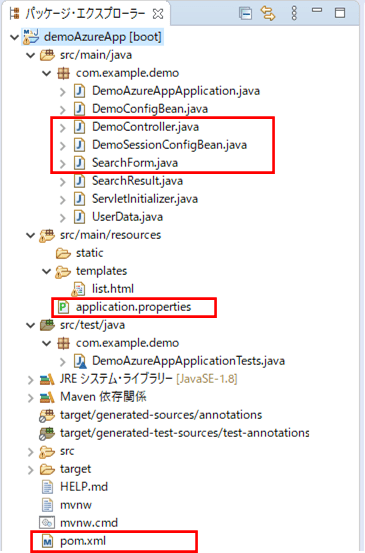
なお、上記の赤枠は、前提条件のプログラムから追加・変更したプログラムである。
pom.xmlの内容は以下の通りで、Spring Session RedisとRedisストア(Lettuce)アダプタを追加している。
<?xml version="1.0" encoding="UTF-8"?>
<project xmlns="http://maven.apache.org/POM/4.0.0" xmlns:xsi="http://www.w3.org/2001/XMLSchema-instance" xsi:schemaLocation="http://maven.apache.org/POM/4.0.0 https://maven.apache.org/xsd/maven-4.0.0.xsd">
<modelVersion>4.0.0</modelVersion>
<parent>
<groupId>org.springframework.boot</groupId>
<artifactId>spring-boot-starter-parent</artifactId>
<version>2.4.0</version>
<relativePath/>
<!-- lookup parent from repository -->
</parent>
<groupId>com.example</groupId>
<artifactId>demoAzureApp</artifactId>
<version>0.0.1-SNAPSHOT</version>
<packaging>war</packaging>
<name>demoAzureApp</name>
<description>Demo project for Spring Boot</description>
<properties>
<java.version>1.8</java.version>
</properties>
<dependencies>
<dependency>
<groupId>org.springframework.boot</groupId>
<artifactId>spring-boot-starter-thymeleaf</artifactId>
</dependency>
<dependency>
<groupId>org.springframework.boot</groupId>
<artifactId>spring-boot-starter-web</artifactId>
</dependency>
<!-- lombokの設定 -->
<dependency>
<groupId>org.projectlombok</groupId>
<artifactId>lombok</artifactId>
<scope>provided</scope>
</dependency>
<!-- Spring Session Redisの設定 -->
<dependency>
<groupId>org.springframework.session</groupId>
<artifactId>spring-session-data-redis</artifactId>
</dependency>
<!-- Redisストア(Lettuce)アダプタの設定 -->
<dependency>
<groupId>io.lettuce</groupId>
<artifactId>lettuce-core</artifactId>
</dependency>
<dependency>
<groupId>org.springframework.boot</groupId>
<artifactId>spring-boot-starter-tomcat</artifactId>
<scope>provided</scope>
</dependency>
<dependency>
<groupId>org.springframework.boot</groupId>
<artifactId>spring-boot-starter-test</artifactId>
<scope>test</scope>
</dependency>
</dependencies>
<build>
<plugins>
<plugin>
<groupId>org.springframework.boot</groupId>
<artifactId>spring-boot-maven-plugin</artifactId>
</plugin>
<plugin>
<groupId>com.microsoft.azure</groupId>
<artifactId>azure-webapp-maven-plugin</artifactId>
<version>1.12.0</version>
<configuration>
<schemaVersion>v2</schemaVersion>
<subscriptionId>(ログインユーザーのサブスクリプションID)</subscriptionId>
<resourceGroup>azureAppDemo</resourceGroup>
<appName>azureAppDemoService</appName>
<pricingTier>B1</pricingTier>
<region>japaneast</region>
<appServicePlanName>ASP-azureAppDemo-8679</appServicePlanName>
<appServicePlanResourceGroup>azureAppDemo</appServicePlanResourceGroup>
<runtime>
<os>Linux</os>
<javaVersion>Java 8</javaVersion>
<webContainer>Tomcat 8.5</webContainer>
</runtime>
<deployment>
<resources>
<resource>
<directory>${project.basedir}/target</directory>
<includes>
<include>*.war</include>
</includes>
</resource>
</resources>
</deployment>
</configuration>
</plugin>
</plugins>
</build>
</project>また、application.propertiesの設定は以下の通りで、「spring.session.store-type=redis」という定義と、Azure Cache for Redisへの接続先を追加している。
server.port = 8084 demoAzureFunc.urlBase = http://localhost:7071/api/ #demoAzureFunc.urlBase = https://azurefuncdemoapp.azurewebsites.net/api/ # Spring Sessionに関する設定 spring.session.store-type=redis spring.redis.ssl=true spring.redis.host=azurePurinRedis.redis.cache.windows.net spring.redis.port=6380 spring.redis.password=(Azure Cache for Redisのパスワード)
なお、上記接続先は、以下のAzure Portal上のプライマリ接続文字列から確認できる。
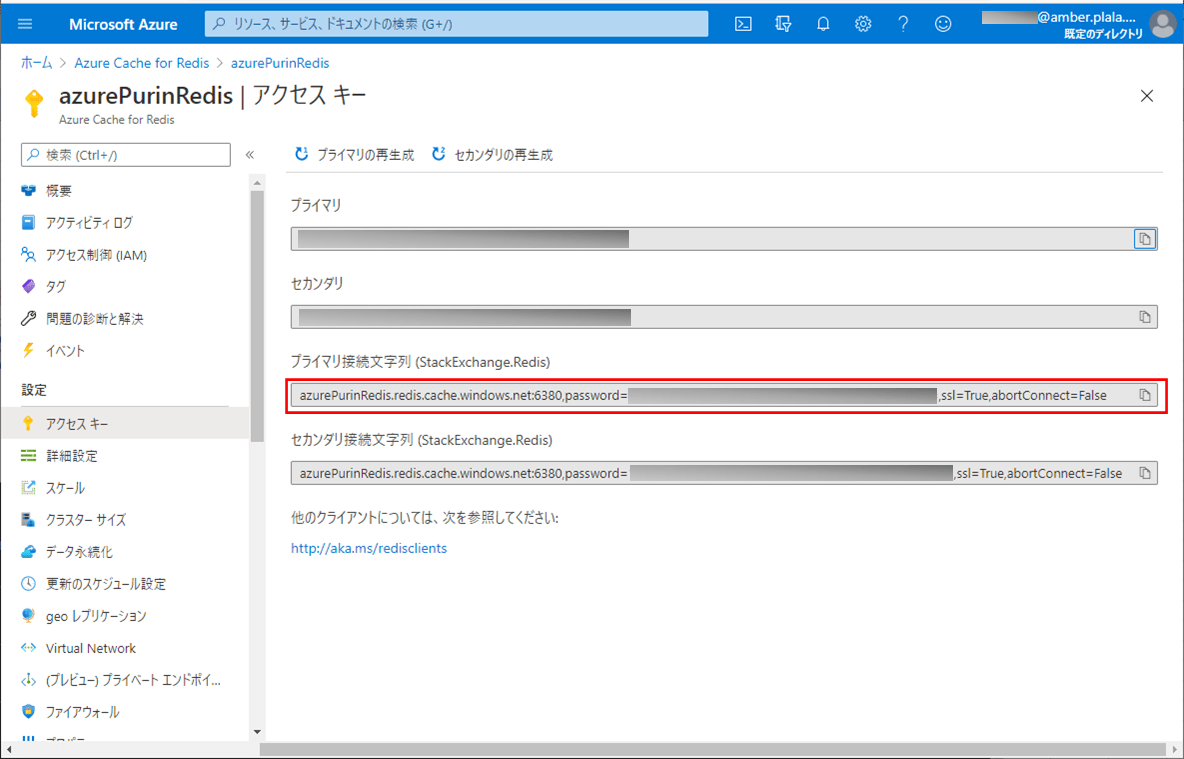
また、Spring Sessionの設定は、以下のクラスで設定している。
package com.example.demo;
import org.springframework.beans.factory.annotation.Value;
import org.springframework.context.annotation.Bean;
import org.springframework.context.annotation.Configuration;
import org.springframework.data.redis.connection.RedisStandaloneConfiguration;
import org.springframework.data.redis.connection.lettuce.LettuceClientConfiguration;
import org.springframework.data.redis.connection.lettuce.LettuceConnectionFactory;
import org.springframework.data.redis.serializer.GenericJackson2JsonRedisSerializer;
import org.springframework.data.redis.serializer.RedisSerializer;
import org.springframework.session.data.redis.config.ConfigureRedisAction;
import org.springframework.session.data.redis.config.annotation.web.http.EnableRedisHttpSession;
import org.springframework.session.web.context.AbstractHttpSessionApplicationInitializer;
@Configuration
@EnableRedisHttpSession
public class DemoSessionConfigBean extends AbstractHttpSessionApplicationInitializer {
/** Azure上のRedisサーバーのホスト名 */
@Value("${spring.redis.host}")
private String redisHostName;
/** Azure上のRedisサーバーのポート番号 */
@Value("${spring.redis.port}")
private String redisPort;
/** Azure上のRedisサーバーのパスワード */
@Value("${spring.redis.password}")
private String redisPassword;
/**
* Redisへの値の書き込み・読み込み手段を提供するシリアライザを生成する
* @return Redisへの値の書き込み・読み込み手段を提供するシリアライザ
*/
@Bean
public RedisSerializer<Object> springSessionDefaultRedisSerializer() {
return new GenericJackson2JsonRedisSerializer();
}
/**
* Spring SessionがAzure上のRedisのCONFIGを実行しないようにする
* @return Spring SessionがAzure上のRedisのCONFIGを実行しない設定
*/
@Bean
public static ConfigureRedisAction configureRedisAction() {
return ConfigureRedisAction.NO_OP;
}
/**
* Redisへの接続方法を生成する
* @return Redisへの接続方法
*/
@Bean
public LettuceConnectionFactory connectionFactory() {
RedisStandaloneConfiguration redisStandaloneConfiguration
= new RedisStandaloneConfiguration();
redisStandaloneConfiguration.setHostName(redisHostName);
redisStandaloneConfiguration.setPassword(redisPassword);
redisStandaloneConfiguration.setPort(Integer.parseInt(redisPort));
LettuceClientConfiguration lettuceClientConfiguration
= LettuceClientConfiguration.builder().useSsl().build();
return new LettuceConnectionFactory(
redisStandaloneConfiguration, lettuceClientConfiguration);
}
}
さらに、コントローラクラスの内容は以下の通りで、検索条件Formクラスをセッションとして保持するようにしている。
package com.example.demo;
import org.springframework.beans.factory.annotation.Autowired;
import org.springframework.beans.factory.annotation.Value;
import org.springframework.http.HttpEntity;
import org.springframework.http.HttpHeaders;
import org.springframework.http.HttpMethod;
import org.springframework.http.MediaType;
import org.springframework.http.ResponseEntity;
import org.springframework.stereotype.Controller;
import org.springframework.ui.Model;
import org.springframework.util.LinkedMultiValueMap;
import org.springframework.util.MultiValueMap;
import org.springframework.web.bind.annotation.GetMapping;
import org.springframework.web.bind.annotation.ModelAttribute;
import org.springframework.web.bind.annotation.PostMapping;
import org.springframework.web.bind.annotation.SessionAttributes;
import org.springframework.web.client.RestTemplate;
import com.fasterxml.jackson.databind.ObjectMapper;
@Controller
@SessionAttributes(names="searchForm")
public class DemoController {
/** RestTemplateオブジェクト */
@Autowired
private RestTemplate restTemplate;
/** ObjectMapperオブジェクト */
@Autowired
private ObjectMapper objectMapper;
/** application.propertiesからdemoAzureFunc.urlBaseの値を取得 */
@Value("${demoAzureFunc.urlBase}")
private String demoAzureFuncBase;
/**
* 検索一覧画面を初期表示する.
* @param model Modelオブジェクト
* @return 検索一覧画面
*/
@GetMapping("/")
public String index(Model model) {
SearchForm searchForm = new SearchForm();
model.addAttribute("searchForm", searchForm);
return "list";
}
/**
* 検索条件に合うユーザーデータを取得し、一覧に表示する
* @param searchForm 検索条件Form
* @param model Modelオブジェクト
* @return 検索一覧画面
*/
@PostMapping("/search")
public String search(@ModelAttribute("searchForm") SearchForm searchForm
, Model model) {
// Azure FunctionsのgetUserDataList関数を呼び出すためのヘッダー情報を設定する
HttpHeaders headers = new HttpHeaders();
headers.setContentType(MediaType.APPLICATION_JSON);
// Azure FunctionsのgetUserDataList関数を呼び出すための引数を設定する
MultiValueMap<String, String> map = new LinkedMultiValueMap<>();
try {
map.add("searchName", searchForm.getSearchName());
map.add("searchSex", searchForm.getSearchSex());
} catch (Exception ex) {
throw new RuntimeException(ex);
}
HttpEntity<MultiValueMap<String, String>> entity
= new HttpEntity<>(map, headers);
// Azure FunctionsのgetUserDataList関数を呼び出す
ResponseEntity<String> response = restTemplate.exchange(
demoAzureFuncBase + "getUserDataList", HttpMethod.POST,
entity, String.class);
// Azure Functionsの呼出結果のユーザーデータ一覧を、検索条件Formに設定する
try {
SearchResult searchResult = objectMapper.readValue(
response.getBody(), SearchResult.class);
searchForm.setUserDataList(searchResult.getUserDataList());
} catch (Exception ex) {
throw new RuntimeException(ex);
}
model.addAttribute("searchForm", searchForm);
return "list";
}
}また、検索条件Formクラスの内容は以下の通りで、getSexItemsメソッドの内容をAzure Cache for Redisに格納しないようにするために、@JsonIgnoreアノテーションを付与している。
package com.example.demo;
import java.util.ArrayList;
import java.util.LinkedHashMap;
import java.util.Map;
import com.fasterxml.jackson.annotation.JsonIgnore;
import lombok.Data;
@Data
public class SearchForm {
/** 検索用名前 */
private String searchName;
/** 検索用性別 */
private String searchSex;
/** 検索結果リスト */
private ArrayList<UserData> userDataList = new ArrayList<>();
/** 性別のMapオブジェクト */
@JsonIgnore
public Map<String, String> getSexItems() {
Map<String, String> sexMap = new LinkedHashMap<String, String>();
sexMap.put("1", "男");
sexMap.put("2", "女");
return sexMap;
}
}その他のソースコード内容は、以下のサイトを参照のこと。
https://github.com/purin-it/azure/tree/master/azure-cache-redis-session/demoAzureApp
サンプルプログラムの実行結果
サンプルプログラムの実行結果は、以下の通り。
1) Azure Redisをコンソールで「keys *」コマンドを入力すると、何も登録されていないことが確認できる。
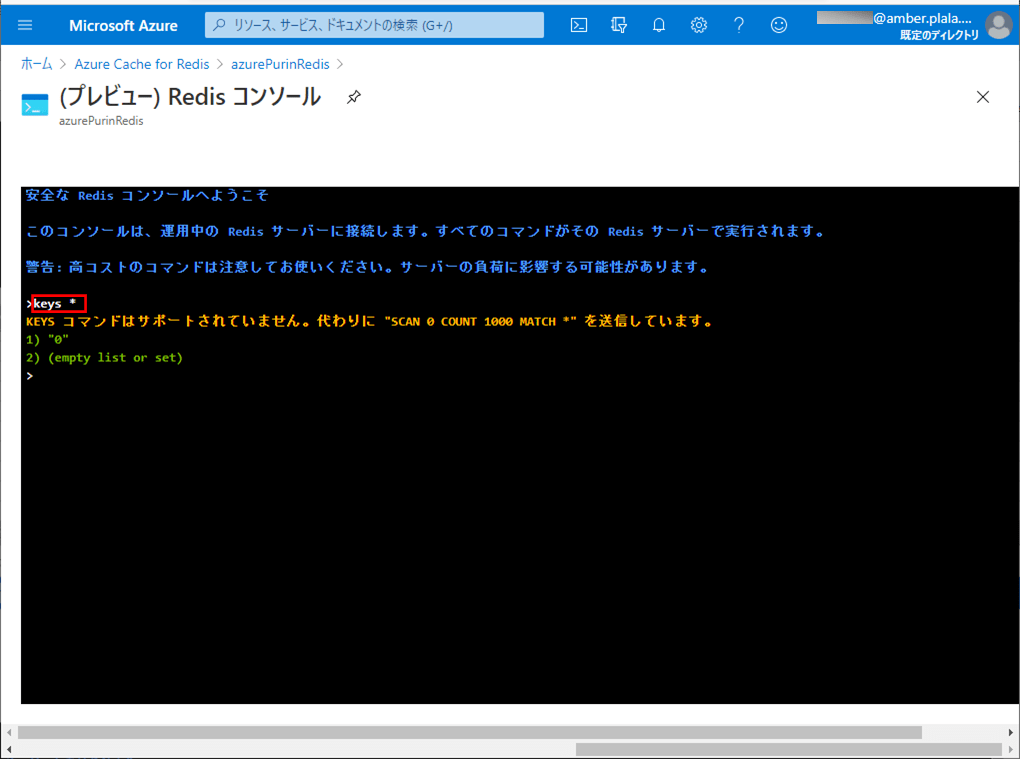
2) ローカル環境でdemoAzureFuncアプリを「mvn azure-functions:run」コマンドで起動する。
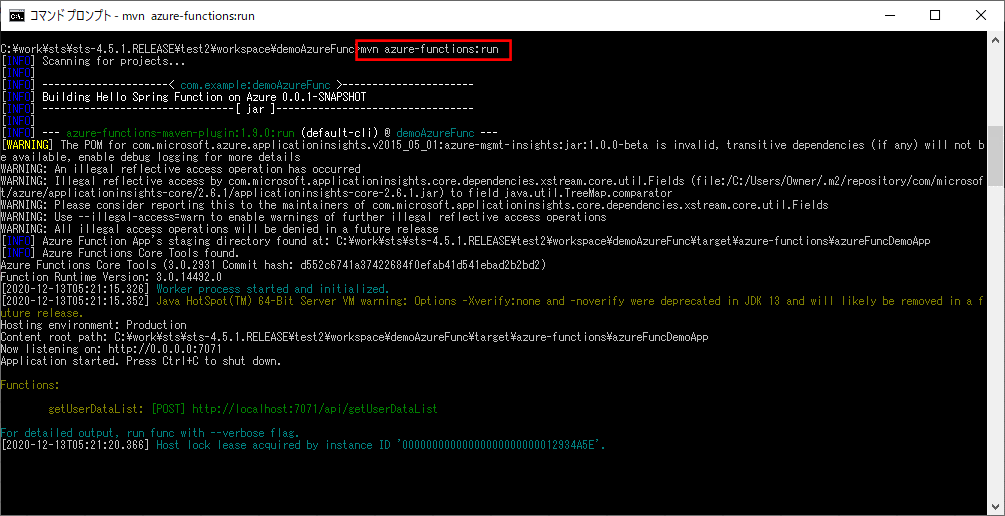
その後、Spring Bootアプリケーションを起動し、「http:// (ホスト名):(ポート番号)」とアクセスすると、以下の画面が表示される。
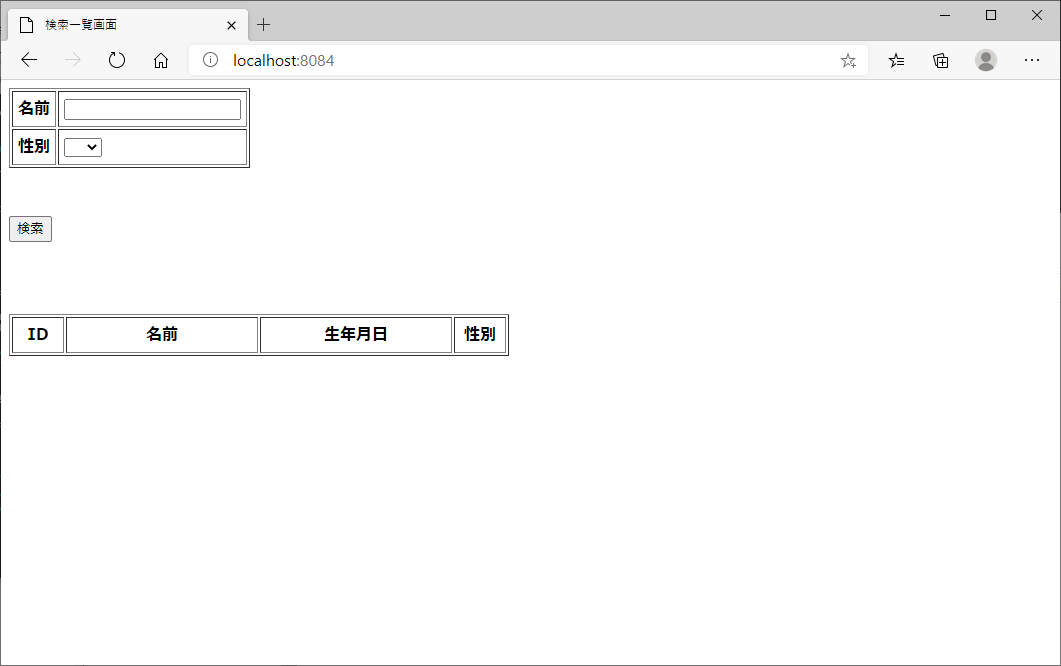
このとき、 Azure Redisをコンソールで「keys *」コマンドを入力すると、Spring Sessionにより作成されたオブジェクトの一覧が表示される。
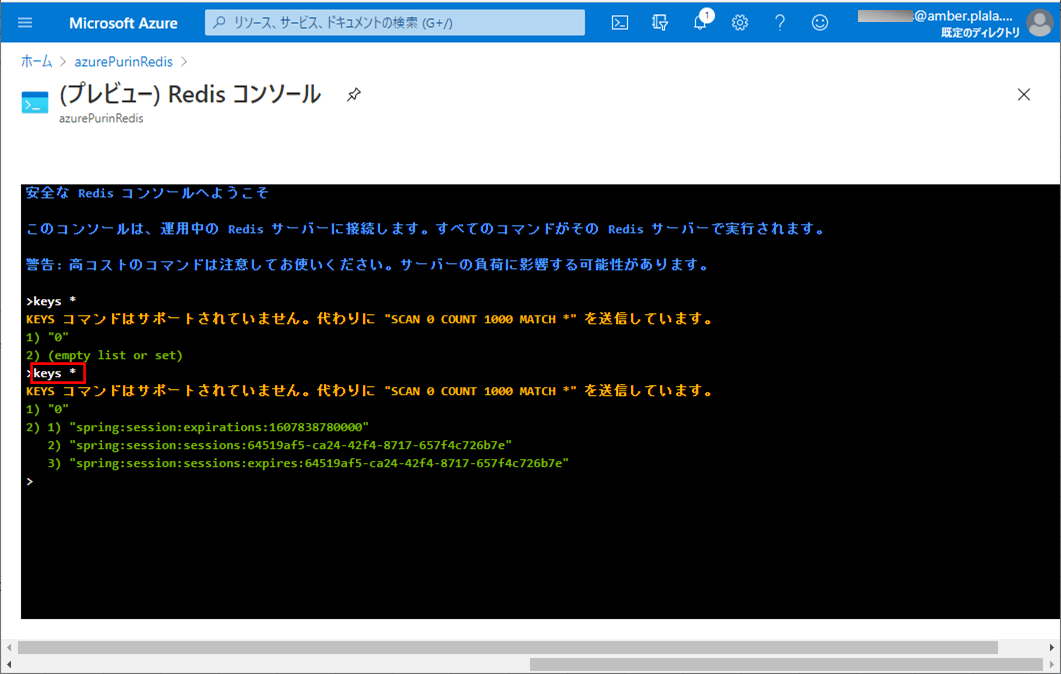
ここで、上記一覧のうち、「expires」を含まない、2)のオブジェクト名を選択し右クリックし、コピーする。なお、コピーした文字列の「spring:session:sessions:」の後の「64519af5-ca24-42f4-8717-657f4c726b7e」は、セッションIDを表している。
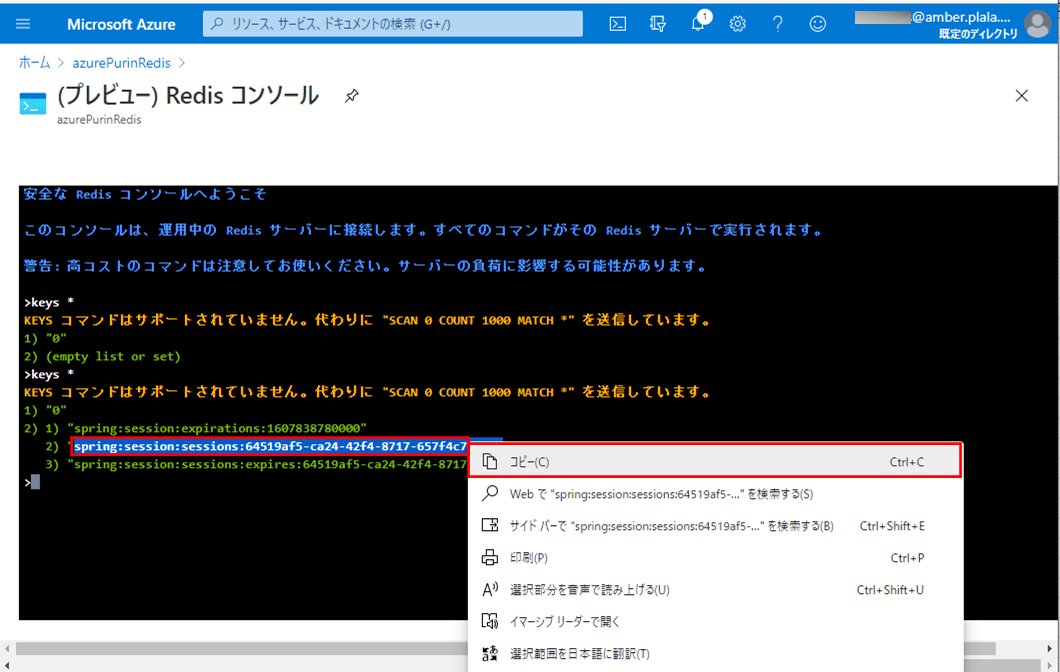
Azure Redisをコンソールで「hgetall (先ほどコピーしたオブジェクト名)」というコマンドを入力すると、以下のように、コピーしたオブジェクト名の中身が表示される。なお、このときのオブジェクト名の貼り付けは、「Ctrl+V」コマンドにより行う。
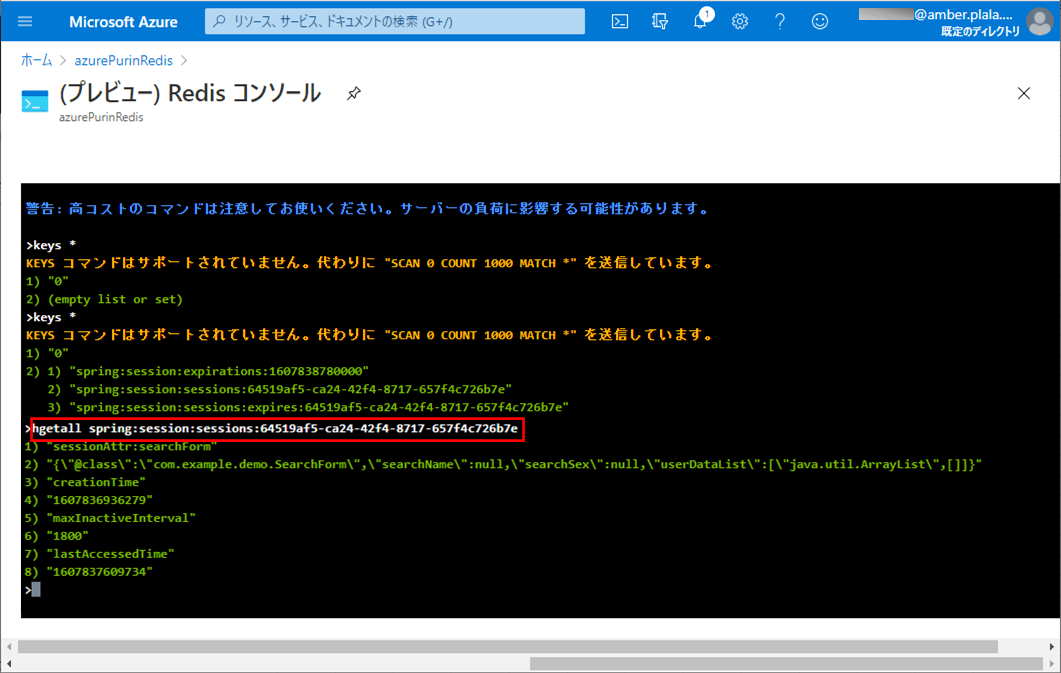
3) 検索条件に何も指定せず「検索」ボタンを押下すると、USER_DATAテーブルの全データが出力される。
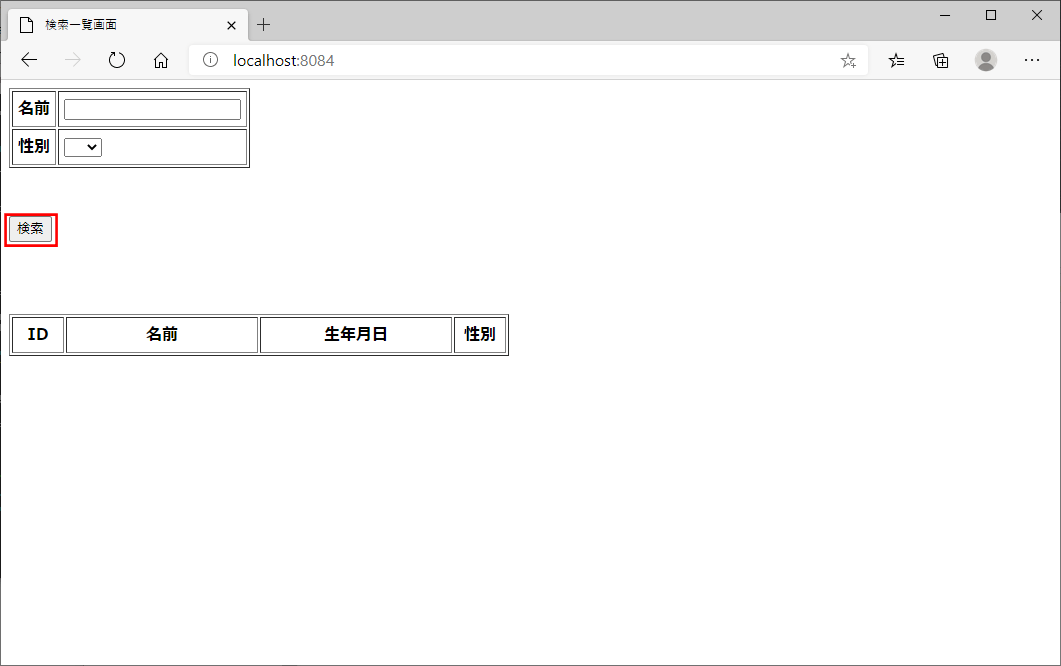
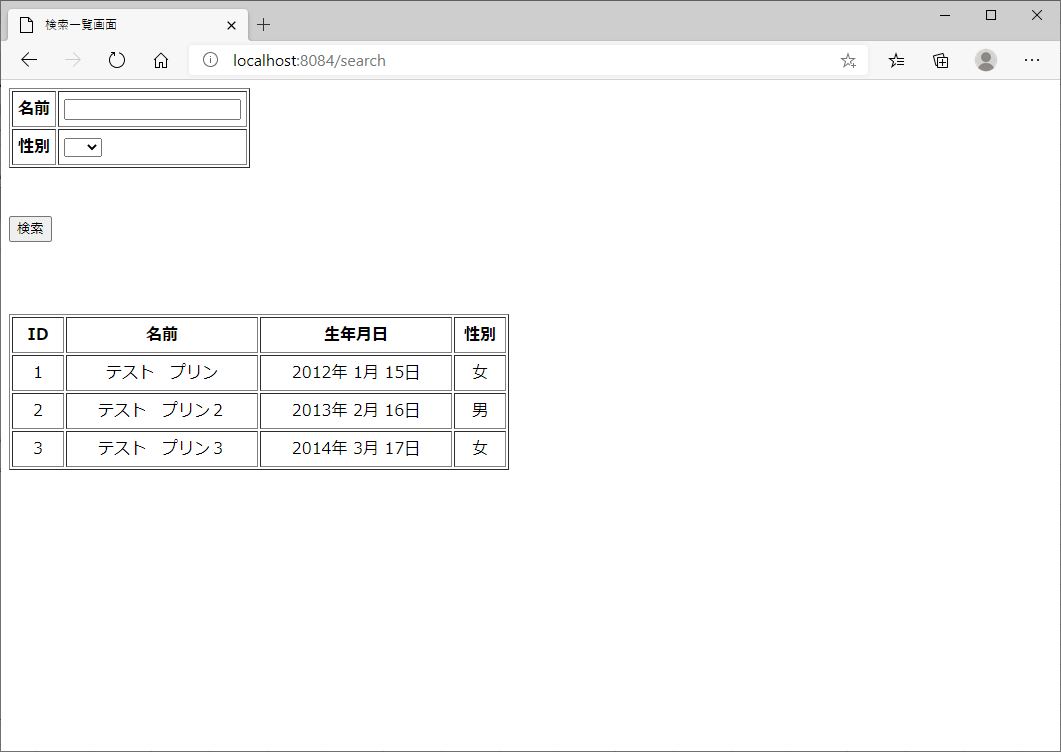
このとき、 Azure Redisをコンソールで「keys *」コマンドを入力後、「hgetall (先ほどコピーしたオブジェクト名)」というコマンドを入力すると、以下のように、コピーしたオブジェクト名の中身が更新されて、userDataListに検索された3レコードが設定されて表示されることが確認できる。
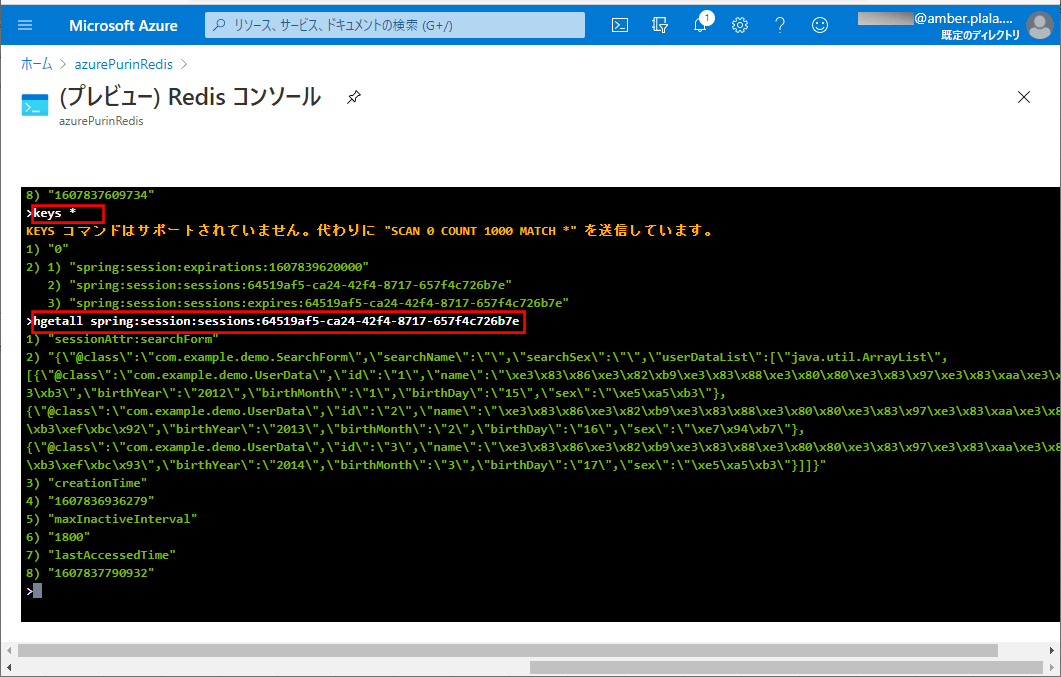
4) 検索条件に「テスト プリン3」、性別に「女」を指定して「検索」ボタンを押下すると、以下のように、条件に合うデータが出力される。
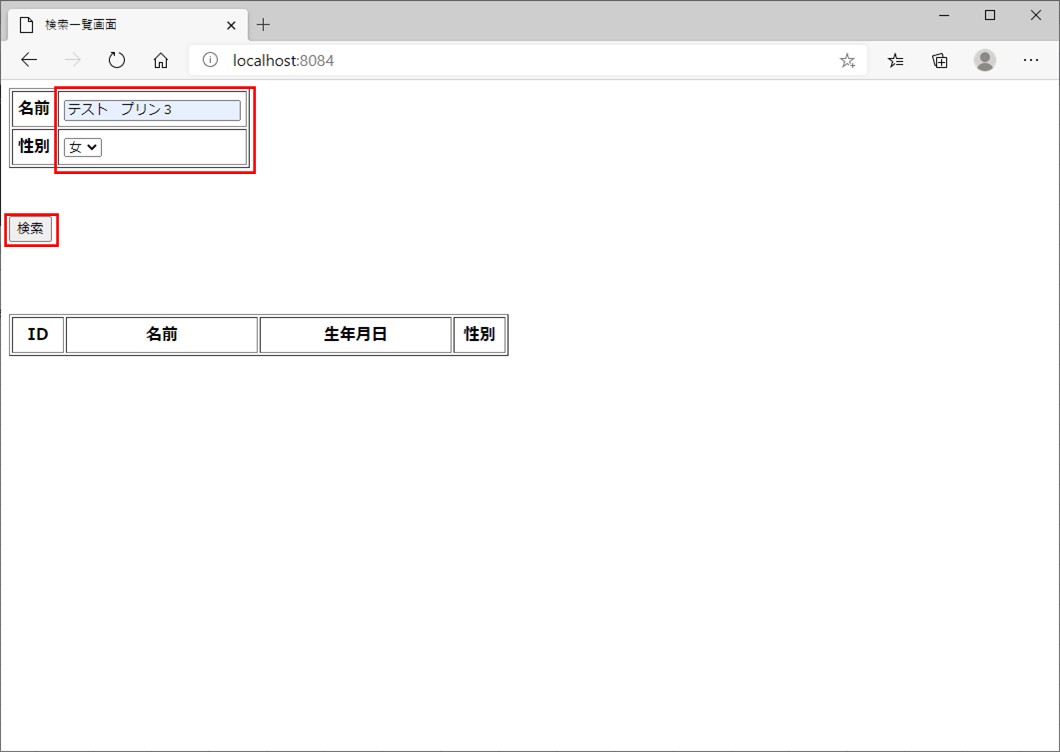

このとき、 Azure Redisをコンソールで「keys *」コマンドを入力後、「hgetall (先ほどコピーしたオブジェクト名)」というコマンドを入力すると、以下のように、コピーしたオブジェクト名の中身が更新されて、searchName, searchSexに検索条件が、userDataListに検索された1レコードが設定されて表示されることが確認できる。
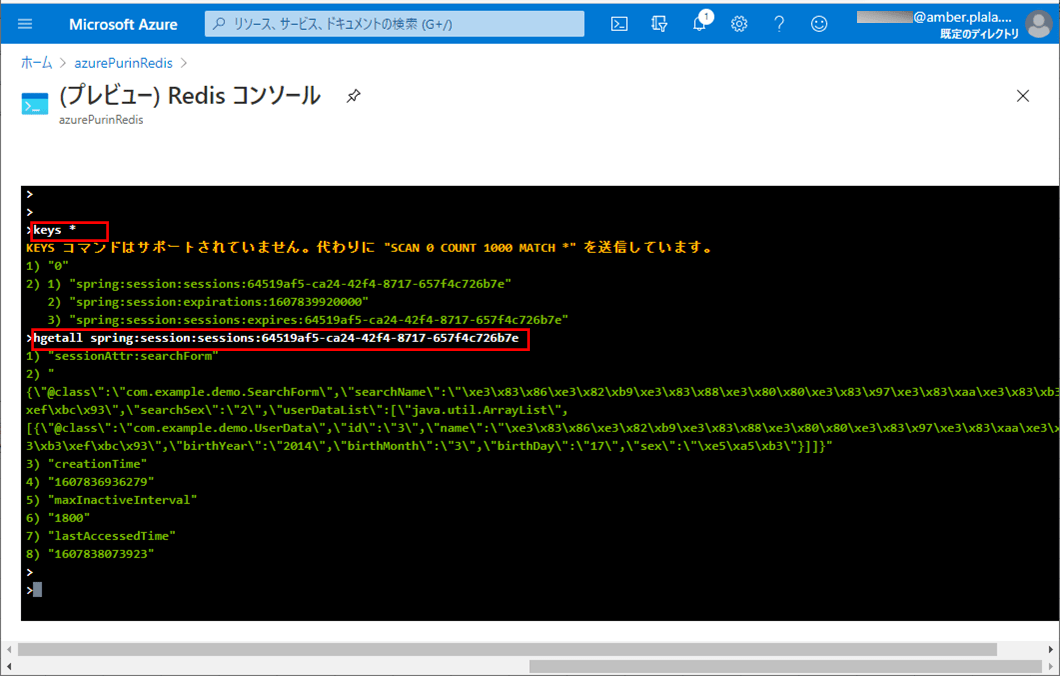
5) 以下のように、「flushdb」コマンドで、Azure Redisオブジェクトのデータが全てクリアされる。
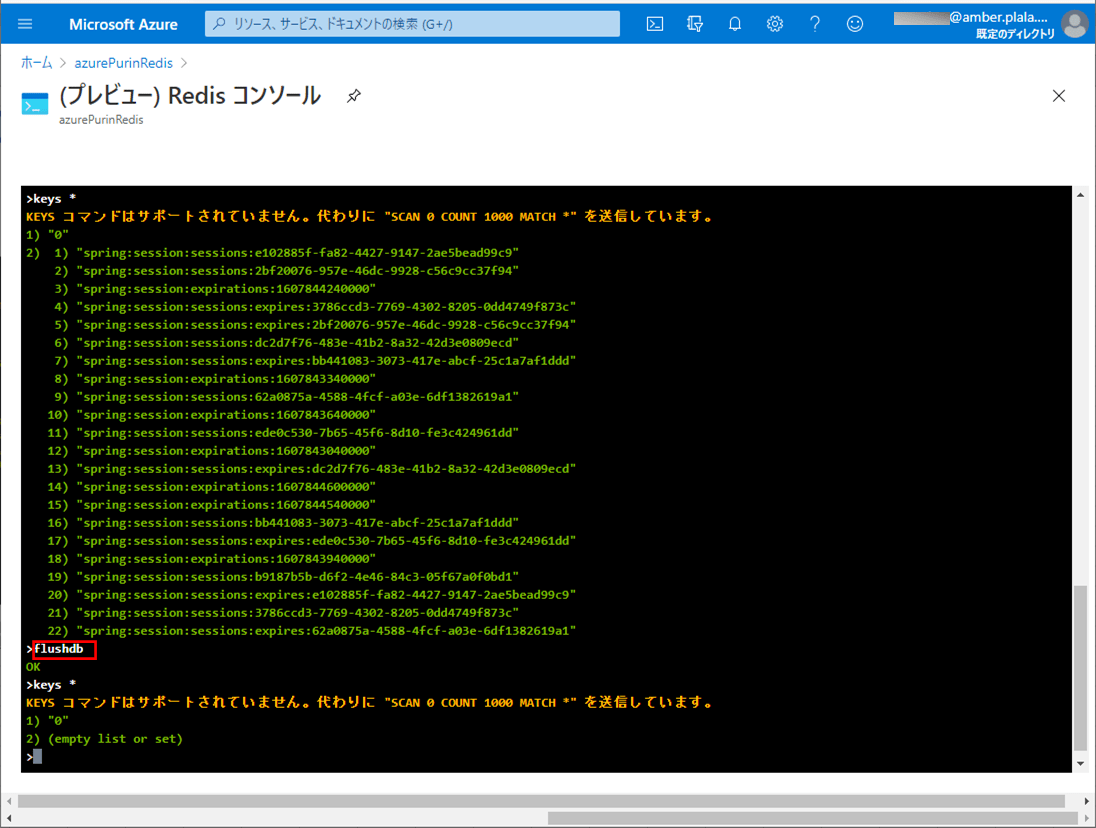
6) ローカル環境でdemoAzureFuncアプリのapplication.propertiesの「demoAzureFunc.urlBase」を以下のように変更する。
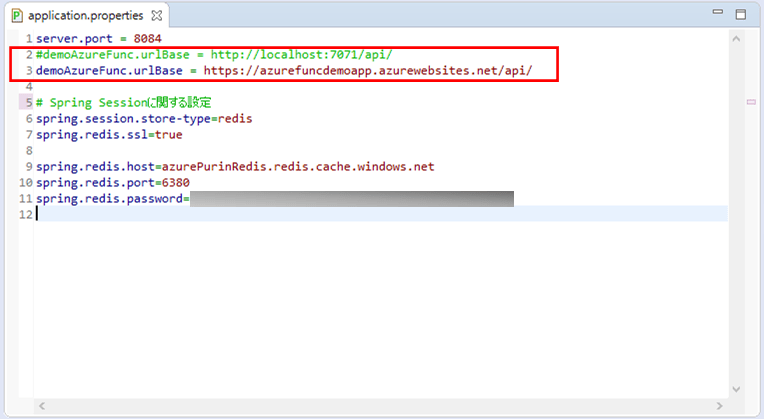
その後、以下のように、Azure App Service上にサンプルプログラムをデプロイする。
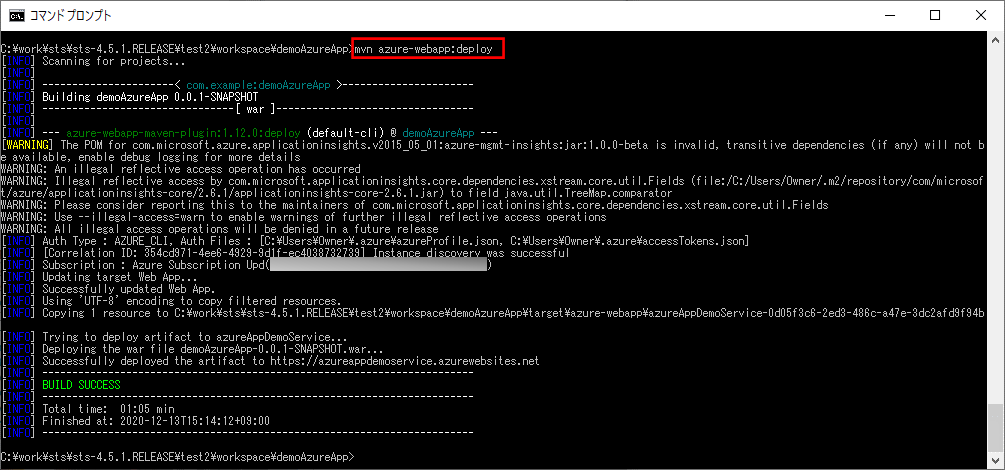
なお、Azure App Serviceにデプロイする過程は、以下の記事の「App ServiceへのSpring Bootを利用したJavaアプリケーションのデプロイ」を参照のこと。

7) その後、「https://azureappdemoservice.azurewebsites.net/」というAzure App ServiceのURLにアクセスすると、以下の画面が表示される。
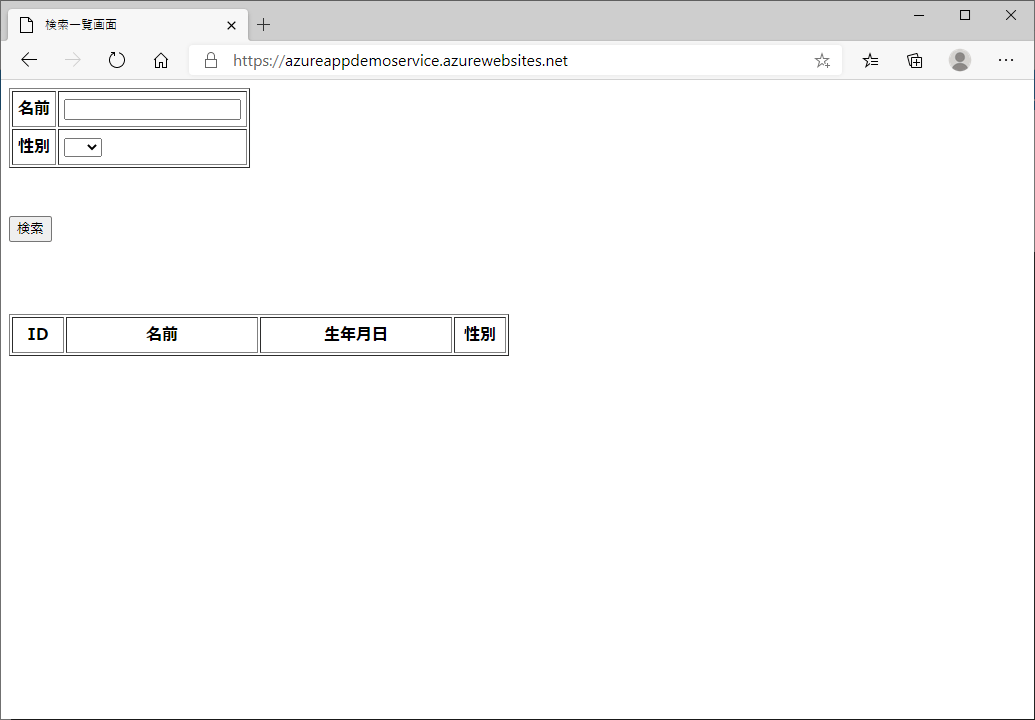
なお、上記URLは、下記Azure App ServiceのURLから確認できる。
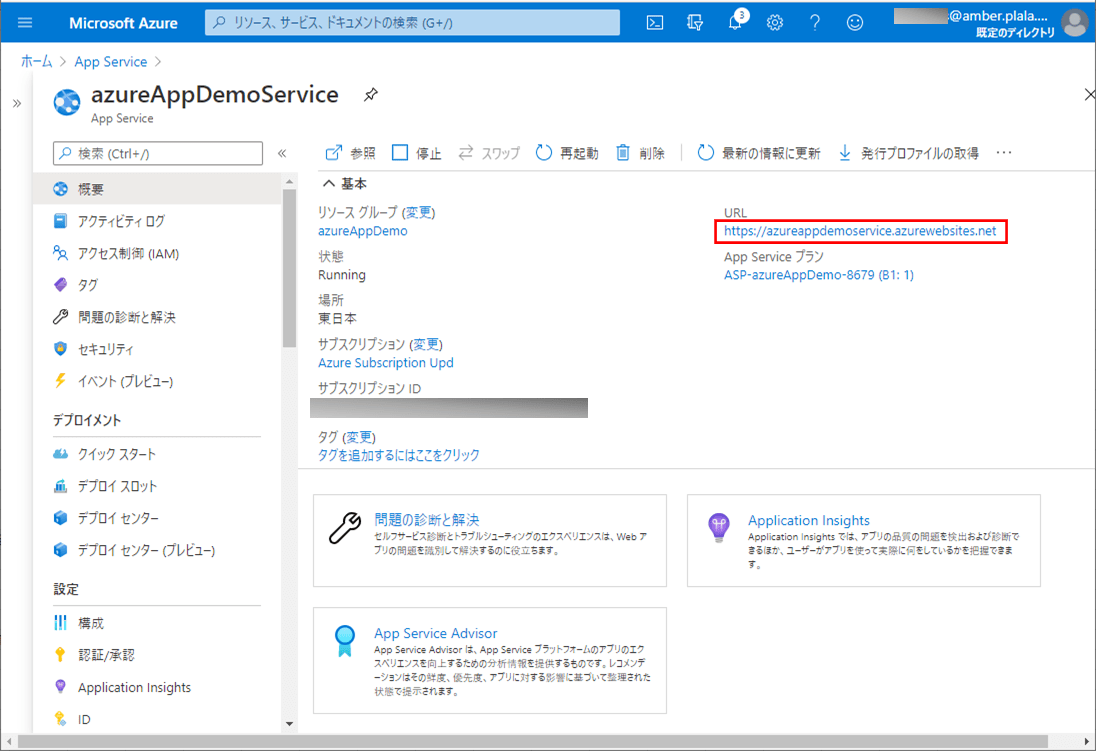
このとき、 Azure Redisをコンソールで「keys *」コマンドを入力後、「hgetall (先ほどコピーしたオブジェクト名)」というコマンドを入力すると、以下のように、コピーしたオブジェクト名の中身が確認できる。
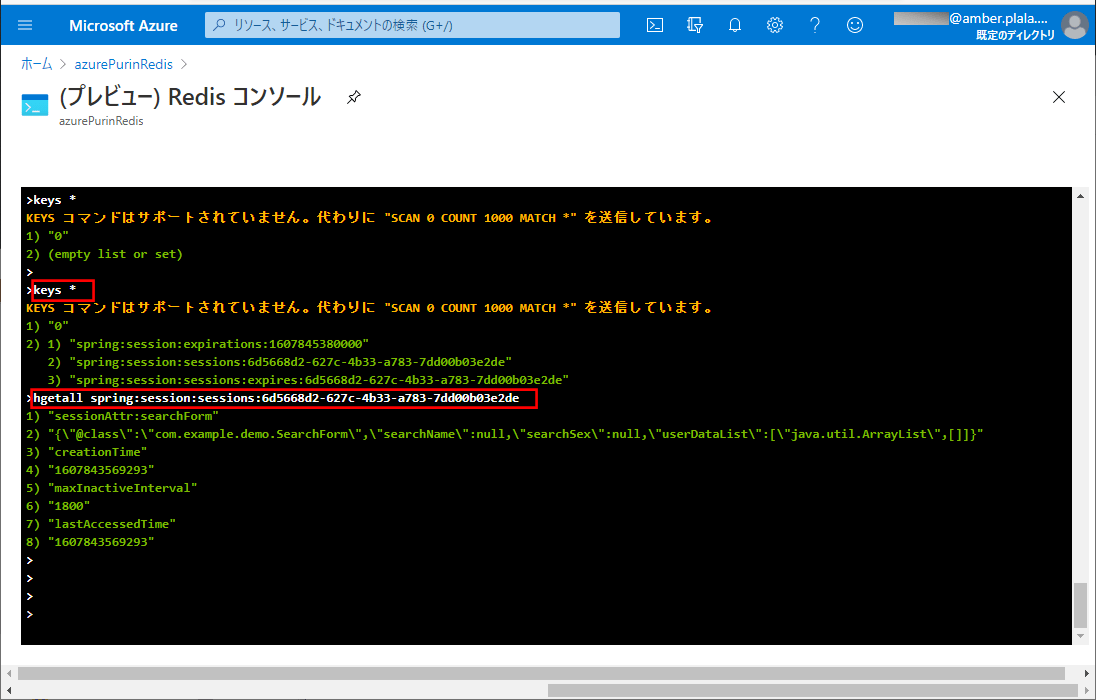
8) 検索条件に何も指定せず「検索」ボタンを押下すると、USER_DATAテーブルの全データが出力される。
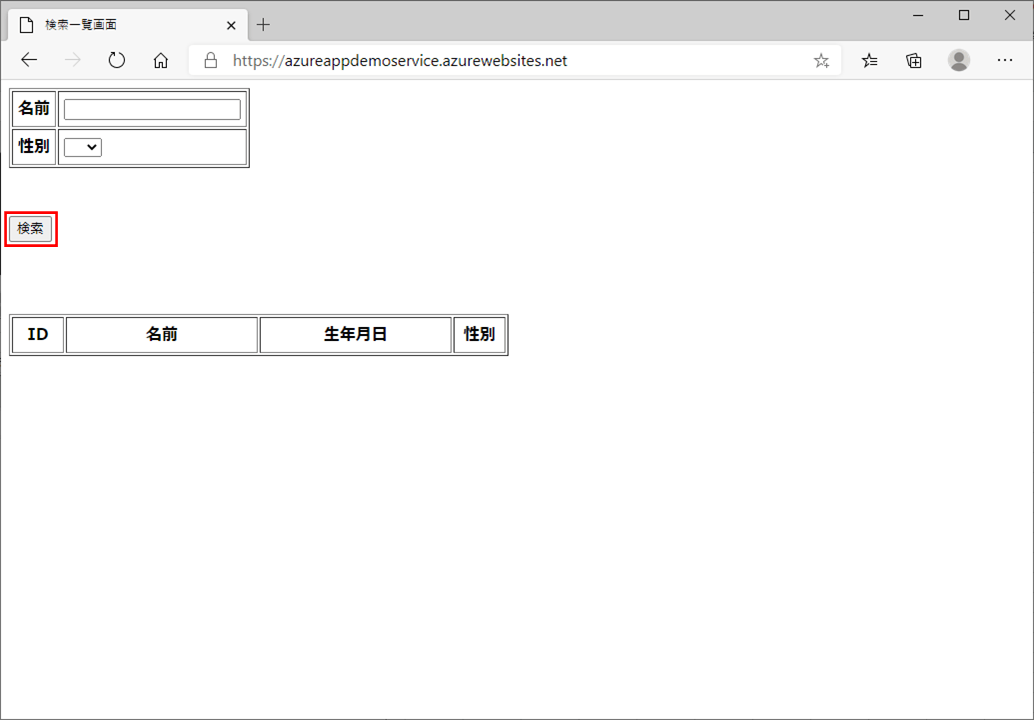
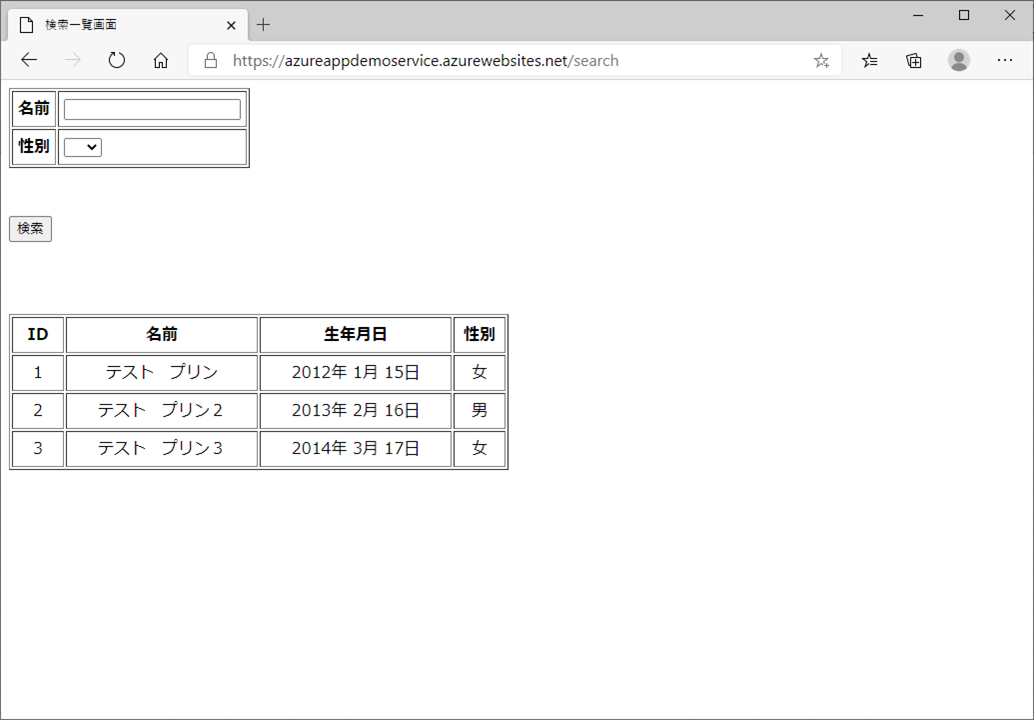
このとき、 Azure Redisをコンソールで「keys *」コマンドを入力後、「hgetall (先ほどコピーしたオブジェクト名)」というコマンドを入力すると、以下のように、コピーしたオブジェクト名の中身が更新されて、userDataListに検索された3レコードが設定されて表示されることが確認できる。
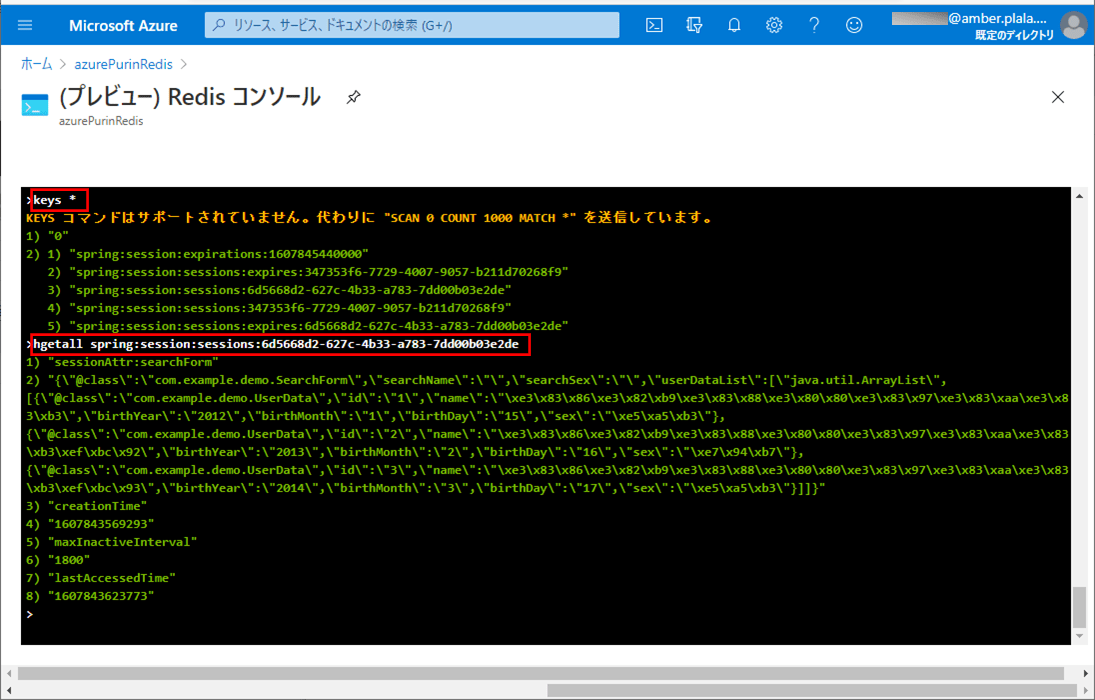
9) 検索条件に「テスト プリン3」、性別に「女」を指定して「検索」ボタンを押下すると、以下のように、条件に合うデータが出力される。
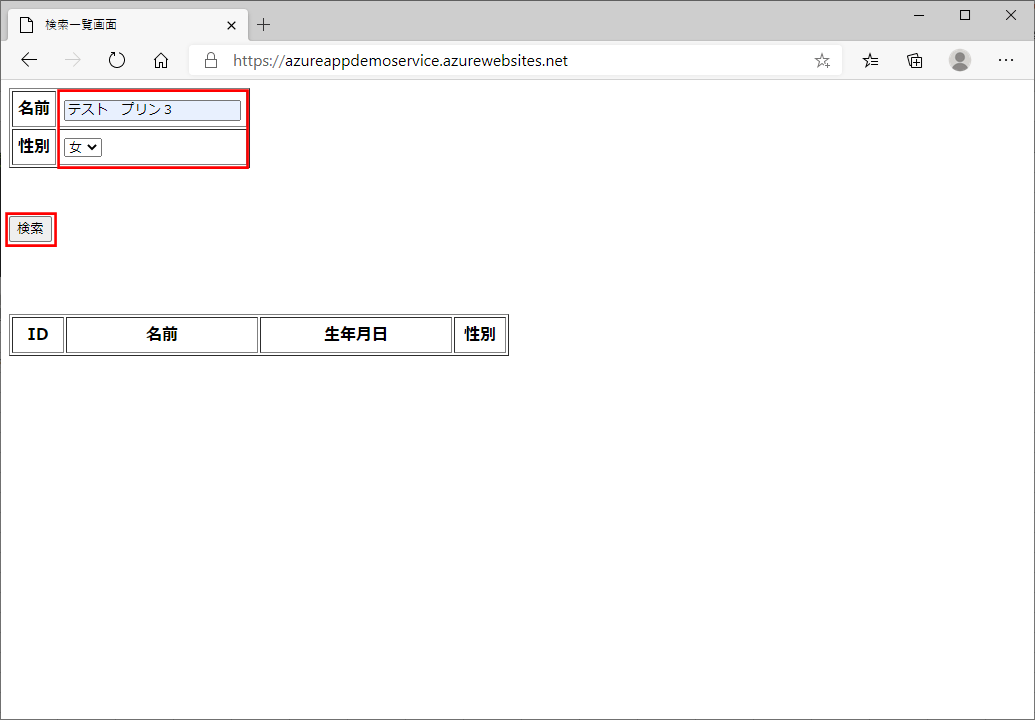
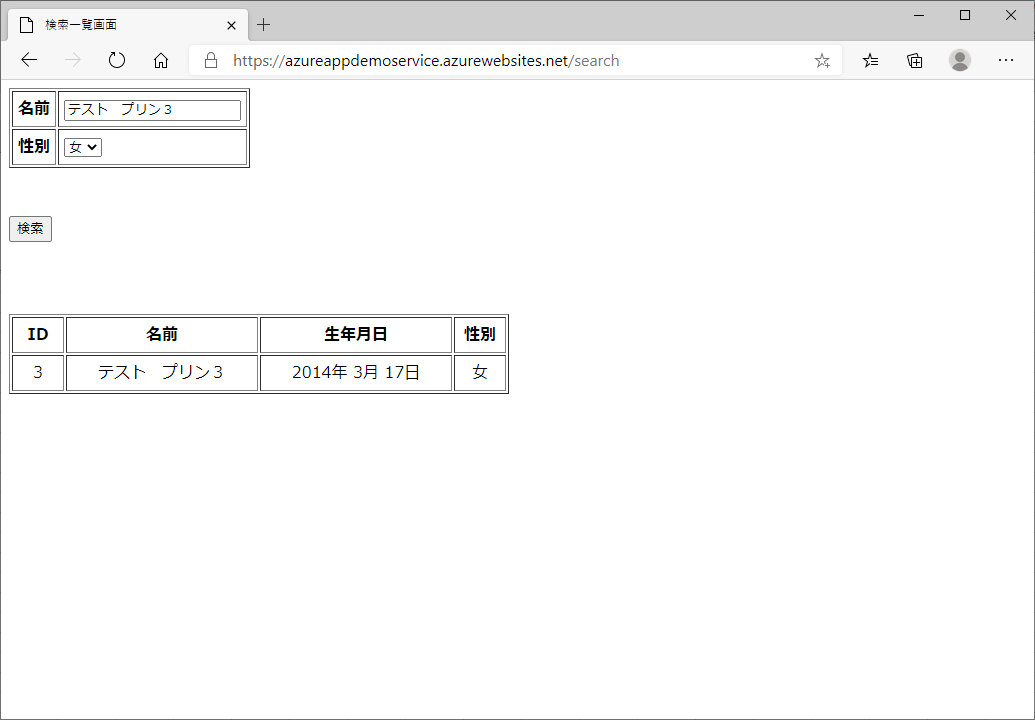
このとき、 Azure Redisをコンソールで「keys *」コマンドを入力後、「hgetall (先ほどコピーしたオブジェクト名)」というコマンドを入力すると、以下のように、コピーしたオブジェクト名の中身が更新されて、searchName, searchSexに検索条件が、userDataListに検索された1レコードが設定されて表示されることが確認できる。
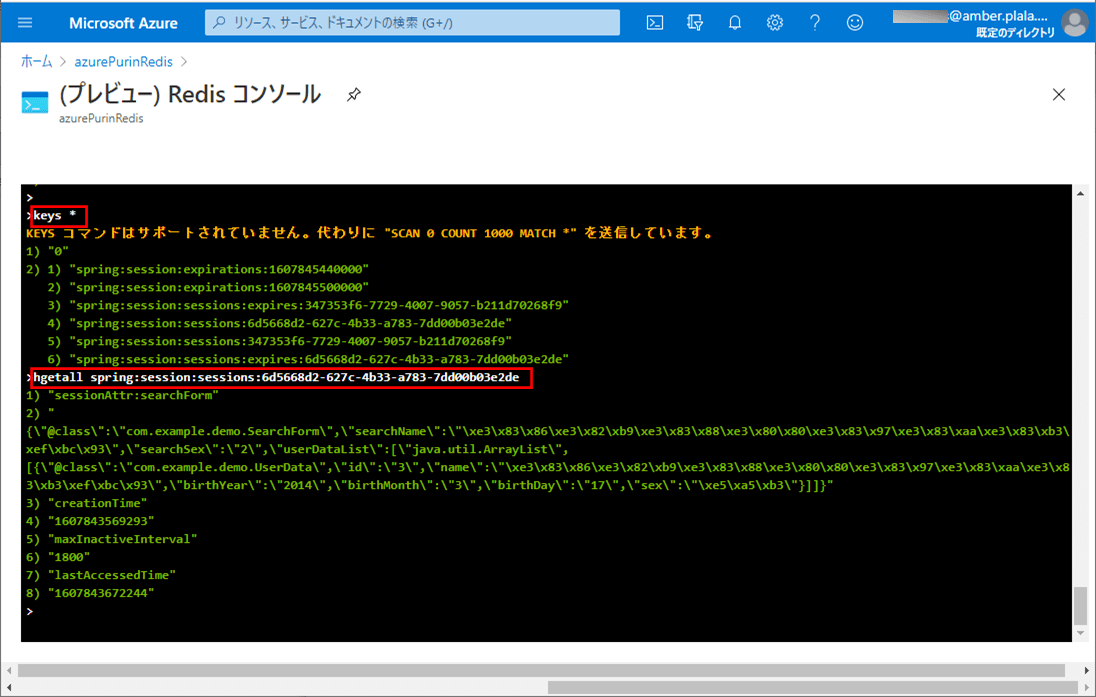
要点まとめ
- Spring Sessionは、ユーザーのセッション情報を管理するための API と実装を提供するため、これを利用すると、セッションデータをAzure Cache for Redisや他のデータベースに格納することができる。
- Azure Cache for Redisにセッションデータを格納するには、Spring Session データ Redis(spring-session-data-redis)を利用し、application.propertiesに「spring.session.store-type=redis」の定義とAzure Cache for Redisへの接続先を追加すると共に、Spring Sessionの設定を行うクラスを追加する。





